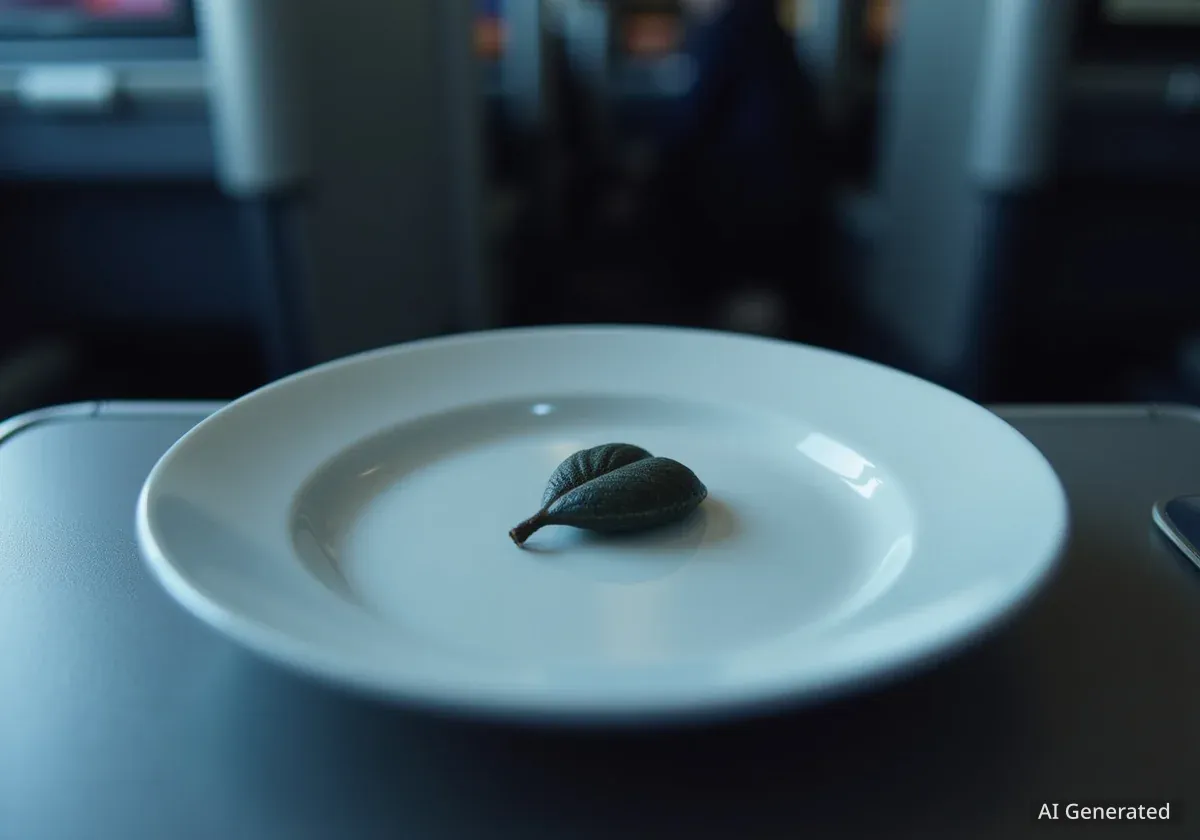A Delta Air Lines passenger flying from Chicago O’Hare to Seattle-Tacoma on October 21, 2025, alleges he was poisoned by a toxic plant found in his first-class meal. The traveler reported severe illness mid-flight after discovering black nightshade, a poisonous weed, in his salad. He claims a flight attendant later confiscated the evidence, stating it was “Delta’s property.”
Key Takeaways
- Passenger reported finding black nightshade in a first-class meal.
- Experienced severe poisoning symptoms mid-flight.
- Evidence allegedly confiscated by a flight attendant.
- Paramedics treated the passenger upon arrival in Seattle.
- Delta offered 3,000 SkyMiles as compensation.
Mid-Flight Illness After Consuming Salad
The incident occurred during a routine Delta Air Lines flight. The passenger, who was returning home after visiting his terminally ill father, ordered the Southwest Harvest Salad from the first-class menu. While eating, he noticed an unusually bitter taste.
He then turned on his overhead light to inspect his meal more closely. It was at this point that he discovered a stalk of black nightshade, complete with flowers, mixed in with his salad greens. Black nightshade (Solanum nigrum) is a known toxic weed.
Fact: Black Nightshade Toxicity
Consuming even a small amount of black nightshade can lead to symptoms such as nausea, vomiting, abdominal pain, and diarrhea within hours. Higher doses may cause confusion, slowed pulse, and, in severe cases, respiratory distress. While fatalities are rare, the plant is not safe for human consumption.
Passenger Reports Contamination
Upon realizing he had ingested a poisonous plant, the passenger immediately reported the contamination to the lead flight attendant, identified as Larisa. He intended to keep the remaining plant specimen as evidence to show to paramedics upon landing.
However, the passenger later discovered that the flight attendant had taken the specimen. He claims she refused to return it or present it to the medical staff who met the aircraft on arrival.
“I intended to keep the remaining plant specimen to show paramedics, but later discovered that the attendant had taken it, refusing to return it or present it to medical staff on arrival,” the passenger stated.
Medical Attention and Airline Response
Upon landing at Seattle-Tacoma International Airport (SEA), paramedics boarded the aircraft. They provided medical attention to the passenger, who was exhibiting symptoms consistent with Solanum nigrum ingestion, including severe nausea, cramping, and vomiting.
Fortunately, the passenger recovered without suffering any long-term harm from the incident. The immediate medical response ensured his well-being.
Delta's Official Statement and Compensation
The passenger later contacted Delta Air Lines to formally report the incident. He described the airline's initial response as dismissive, stating they offered him only 3,000 SkyMiles as compensation.
Delta Air Lines provided a statement regarding the incident:
“We take this report seriously and remain in touch with the customer. Our next steps are to investigate what is being said, and we’ll go from there. Delta has stringent security and quality assurance measures embedded within our onboard food and beverage operation.”
This statement emphasizes the airline's commitment to food safety and its intention to investigate the passenger's claims.
Context: Airline Food Safety
Airline catering operations are subject to strict food safety regulations to ensure passenger well-being. However, incidents involving foreign or toxic materials can still occur due to the complex nature of supply chains and the reliance on outsourced catering services. Such contamination incidents highlight potential breakdowns in ingredient sourcing or quality control at the supplier level.
Broader Implications for Food Safety
The presence of black nightshade in an in-flight meal raises significant questions about food safety protocols. It suggests a potential lapse in the quality control process, either during the harvesting of ingredients or during meal preparation by catering services.
For passengers, experts recommend specific actions if they encounter unusual food. It is important to report any strange taste or appearance immediately. Passengers should avoid consuming the contaminated food further and document the evidence, ideally with photographs.
Physical evidence, like the plant specimen in this case, is crucial. It aids both medical evaluations and airline investigations into such incidents.
Previous Food Safety Incidents
This is not the first time Delta Air Lines has faced food safety concerns. Last year, the airline temporarily limited meal choices on several international routes following another in-flight food contamination incident. That event led to an emergency landing.
The previous incident affected 75 flights worldwide. Delta prioritized passenger safety and food quality assurance measures during that period. The precaution followed a flight from Detroit (DTW) to Amsterdam (AMS) that diverted to New York’s John F. Kennedy Airport (JFK).
Multiple passengers fell ill on that flight after consuming allegedly moldy chicken. Crew members also reported mild symptoms. Delta confirmed the temporary meal changes lasted only two days before full service resumed, restricting international economy class meals to a single pasta dish.
These past events underscore the ongoing challenges airlines face in maintaining consistent food safety across their extensive global operations. They also highlight the importance of robust quality control throughout the entire catering supply chain.
- July 3, 2024: Detroit to Amsterdam flight diverted to JFK.
- Cause: Multiple passengers and pilots fell ill after consuming allegedly moldy chicken.
- Airline Response: Delta temporarily suspended standard meal variety on 75 international flights.
- Duration: Meal restrictions lasted two days, then full service resumed.
Delta Air Lines continues to emphasize its commitment to stringent security and quality assurance within its food and beverage operations. However, incidents like these demonstrate the complexities involved in ensuring every meal served meets the highest safety standards.





